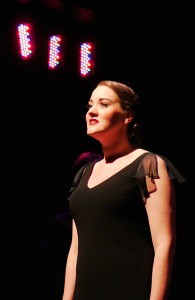Vancouver’s Pacific Theatre kicked off the new year with Underneath the Lintel, on stage until Jan. 31. Though it seems the well-known Emmy-winning playwright Glen Berger did not intend the bigotry implied by his play, his thematic choices create a serious problem nonetheless. This Lintel comes to Vancouver from Alberta’s Rosebud Theatre. (Spoiler alert: the ending of the play is revealed and discussed below.)
While British, Canadian and American critics have given the play mixed reviews, some have argued that it’s not antisemitic, unlike the story that inspired it. And it’s been a hit with producers, who have given it numerous productions across North America and even a run in London’s West End starring Richard Schiff of West Wing fame.
Berger’s 2001 comedy is a contemporary adaptation of the allegorical medieval Christian myth of the Wandering Jew, a figure that has served for centuries as a symbol of the Jewish people’s rejection of Christianity.
Many readers will be familiar with the story, which tells the tale of a Jewish cobbler in Jerusalem who ignores Jesus’ plea for help on his way to crucifixion. The 13th-century fable tells us that, in response, Jesus cursed the Jew. To paraphrase, Jesus says: “For your failure to demonstrate kindness, you are doomed to wander the earth, without rest, until we meet again.” The cobbler is forced to leave his family and wander the earth, alone and unloved, until the Second Coming. He still wanders today, exhausted (in some versions, wicked) and waiting for Jesus to return.
According to historian Salo Wittmayer Baron, the legend became popular with the audiences for medieval passion plays in which the fable was enacted. “Although, from the outset, everyone realized that [the cobbler] had been a Jerusalemite Jew, he now began to be identified with the unconverted eastern Jew still alive in modern times,” he writes in Social and Religious History of the Jews: Late Middle Ages (vol. 10). The first written record of the fable is from the 13th century; indeed, it becomes the very first mass publication when its German-language version is published in 1602.
Underneath the Lintel follows a Dutch librarian (called Librarian in the program) around the world as he searches for the person who returned a library book that was 113 years overdue. During his international pursuit of the culprit, Librarian tells us, he realizes he may, in fact, be following in the footsteps of the Wandering Jew. He then shares the basics of the medieval fable with the audience (without context or dwelling on the work’s antisemitic history) and reasons that if he has discovered that the Wandering Jew really exists, this also proves that God exists. Librarian is awed and thrilled by that possibility, and the play turns into his search for God. Soon, however, the audience realizes what Librarian does not: he may be the Wandering Jew himself.
The play’s only character is Librarian (a very good Nathan Schmidt). Librarian never judges (a punishing) God’s treatment of the Wandering Jew. In a 2013 essay for American Conservatory Theatre, Berger writes that the Wandering Jew is guilty of a “mistake, a simple mistake.”
This Pacific Theatre production is a very good play, and the story of Librarian is compelling; two features irrelevant to the content of the script. Undoubtedly, the script’s problem is the result of sloppy writing and a somewhat ignorant reading of what the Wandering Jew folktale implies. The playwright seems very naïve.
In a 2013 interview with JWeekly, Berger said, “Up to the 19th century, the Wandering Jew was considered a condemnation of Jews and Judaism, because he wasn’t very nice to Jesus and consequently got punished for it. I think people just know The Wandering Jew as an antisemitic tale in any context.” Including this one? He doesn’t say, but it appears that Berger believes he’s cleansed the fable of its offensiveness. It’s just another cautionary tale now, his script implies, like The Little Mermaid or Pinocchio.
Berger signals a slight shift in the American Conservatory Theatre essay. He writes, “Now, I was quite aware that the myth of The Wandering Jew was originally an antisemitic tale, but the myth had taken on more complex meanings in its 700-odd-year history and I felt, besides, that an artist can always appropriate myths for his own ends.”
This is true. Artists can do whatever they want with whatever they want. What Berger has done here, however, is confirm the conclusion of the original antisemitic folktale. A more “complex meaning” than simple bigotry is tough to imagine.
In this play, the Wandering Jew commits his “crime” while standing “underneath the lintel” of his front door. He watches but ignores the procession of the condemned. When Jesus falls before his door and begs for help, the Jew remains still. In some version of the tale, the Jew strikes Jesus or tells him to hurry. Berger writes in the program’s playwright’s note: “[The Wandering Jew’s] predicament is the predicament of all humanity – he made a mistake, a single mistake ‘underneath the lintel,’ when he put fear and self-interest ahead of compassion. Everyone does this all the time.”
Berger, therefore, reduces the fable to “people make mistakes.” What mistake? Was it a mistake to reject Jesus and Christianity? In whose eyes? Berger allows: “Did the punishment fit the crime? No.” But guilty nonetheless, he implies: there has been a crime. Perhaps Berger thinks the sentence a little long. He never articulates his thoughts on the punishment beyond its failure to fit the transgression.
“I’ve received letters calling Underneath the Lintel antisemitic,” Berger writes. “That said, I’ve also received letters calling the play too ‘pro-Zionist,’ and also ‘anti-Christian,’ for the portrayal of a cruel Christ, I suppose. So go figure.”
In the end, of course, we discover that Librarian might actually be the Wandering Jew and just not know it. On the surface, we learn that the Dutch librarian is also guilty of “a mistake” that has ruined his life. Underneath his own lintel, Librarian rejected the only woman he ever loved. The cost of that mistake is loneliness and an obsessive pursuit of the Wandering Jew that forces him to travel the world. Berger, here, equates Librarian’s mistake with the Jew’s mistake. Librarian rejected a woman; the Jew rejected Jesus. Only one was punished for eternity. Librarian, however, has free will.
It’s difficult to understand why the vast majority of critics do not notice the play’s antisemitism, and why, those who do insist on announcing that it is not antisemitic.
Some audiences will surely argue that the play is not antisemitic but, rather, about antisemitism. Not evident, I believe. Others will compare the retelling of this legend to the problematic Merchant of Venice. But this is a contemporary play, not the revival of a period piece. Some will argue that the play questions God’s fundamental justice: it does not.
Underneath the Lintel was written by an American Jew to entertain and provoke audiences; one might say that The Wandering Jew was written by medieval Christians to entertain and provoke audiences – but, more to the point, to promote hatred and violence. The playwright succeeds in diminishing the true meaning of The Wandering Jew when he equates it, thematically, with a simple story of lost love.
As a final “surprise,” as the play ends, Librarian transforms into a cartoon Jew. He already has a beard and an accent that sounds Yiddish. Now, he dons an old black suit that we’re told is dirty and smelly. The jacket bears the Star of David we’re told Jews were forced to wear in the 15th century. He wears the funnel-shaped cap Jews were forced to wear in the 14th century. He holds a prayer book in one hand and (what appears to be) a candlestick in the other.
Costumed thus, he dances Tevye-style to klezmer music and the play ends. This final image smacks of historic – and overtly – racist portrayals of the Wandering Jew in art. If Berger intended to comment on this image, on this object of scorn, he forgot to do so. The play ends instead with the comic dance of the Jew.
Michael Groberman is a Vancouver freelancer writer.










